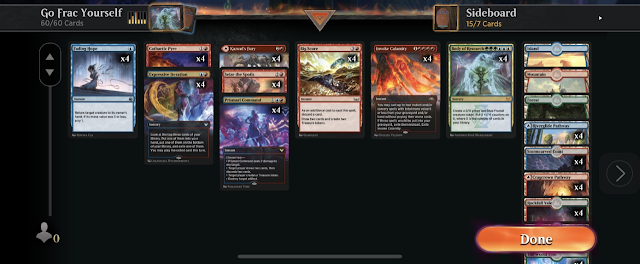Go Frac Yourself
Side Note Story Time
I built Magic cards in Magic R&D/Studio X during the early portion of my WotC career, but moved into the tech realm pretty quickly. Still, that team is near and dear to my heart and I count many friends amongst that part of the org and stopped by regularly to bust chops and chat. At one point a few years ago I saw a battle taking place that featured a mess of a board state and it dawned on me how many mechanics we had released that relied on non-creature tokens. Treasures, clues, blood, shards, food, the list felt like it went on and on. I coined the phrase, “fiddly bits,” to refer to this class of object though the verb tense of “fiddling a bit” or “fiddling your bits” when you make new ones didn’t really fit all that well in a professional setting so I’m certain it didn’t catch on outside of me using it at Draft Night. Still, Magic has a lot of fiddly bits these days, so do with this information what you will.
Back to the main story: two-card combos have been known to warp a format or two in Magic’s history and I knew I wanted to take a crack at things. I abandoned the UR Dragon shell and focused instead on the combo itself. My initial build mistakenly included Unexpected Windfall instead of the superior Big Score from Streets of New Capenna. I named it “Go Frac Yourself” because it’s hilarious (to me), I don’t have to write #wotcstaff at the end of my tweets so a tongue-in-cheek f-word reference doesn’t represent a career risk anymore, and because your goal is to make a giant Fractal and punch someone with it. Also, names never stick on decks so call it whatever you want (but “GFY” is very short!). Here’s the decklist:
Go Frac Yourself
4 Body of Research (STX) 168
1 Dreamroot Cascade (VOW) 262
4 The World Tree (KHM) 275
4 Kazuul's Fury (ZNR) 146
1 Island (SLD) 64
4 Seize the Spoils (KHM) 149
4 Big Score (SNC) 102
4 Prismari Command (STX) 214
4 Fading Hope (MID) 51
4 Cathartic Pyre (MID) 133
4 Invoke Calamity (NEO) 147
4 Riverglide Pathway (ZNR) 264
4 Stormcarved Coast (VOW) 265
4 Cragcrown Pathway (ZNR) 261
4 Rockfall Vale (MID) 266
1 Mountain (SLD) 66
1 Forest (SLD) 67
4 Expressive Iteration (STX) 186
I learned pretty quickly you’re playing two two-card combos: Body of Research and Kazuul’s Fury or Body of Research cast using an end of turn Invoke Calamity while they’re tapped out, then attacking for lethal on your turn. You can do the second combo as early as turn 4 with the help of a third turn Seize the Spoils or Prismari Command to accelerate you. One-shotting them takes 9 mana for BoR and Fury, or 8 mana if you’re using Invoke and Fury.
Important Things I Learned About the Deck
Back in my Iowa days my team and I were testing for a large event called Regionals that qualified you for the National Championship. It was original Affinity Standard days and the architect of our version of the deck centered his testing around the adage: check to see if you can kill your opponent every turn. I found that was truer with this deck than I initially realized, as a lot of decks aren’t ready to deal with the two-card combo and playing to your outs to hit the combo instead of being defensive is often better. I also go for the combo as soon as I have it. I am rewarded for doing so with a victory far more than I am punished with defeat. After all, even if they’re ready for the first combo, you’ve still got time to go for it again making the math heavily favor “try to kill them as soon as you can.”
Manage your mana carefully. Typically, you want access to a single blue mana and as much red as you can get. The manabase should be reworked to get rid of the Forest, which is terrible, because Invoke Calamity is so thirsty for red mana and you don’t want to use Treasures to cast it if you can avoid doing so. You’re casting Body of Research with Calamity, Treasure, or the help of The World Tree and five other lands and the Forest is never going to help you. I think it probably needs to swap for a Mountain.
Against decks that are playing a control game, you’re simply trying to discard your creature removal spells to your card draw to build up a mana surplus they can’t play around. That helps nullify cards like Syncopate and your game plan centers around building to The Big Turn so that you can fight during their end step with Invoke Calamity in order to untap and combo. Keep an eye on having 1RRRR and being able to “go off” with a lethal sized Fractal early in the event they tap out on their turn for something silly. Also, flashing back Memory Deluge during your end step is a play control players make thinking you’re doing Goldspan Dragon things and not realizing they’re dead if you have the combo, so watch for that opportunity as well.
Thalia into a PVDDR is very difficult to beat. White Weenie reduced in popularity over the week I was playing, so it didn’t come up often, but your hope is to be on the play and have an early removal spell. Speaking of which, I typically mulligan hands that don’t have an early play against creatures if they’re aggressive. On the play Prismari Command might be good enough, but on the draw it’s much riskier.
Green and Red decks can’t kill a Fractal. Anything with Blue, Black, and White can, though white decks typically can only kill it on your turn if they’re playing Valorous Stance or Fateful Absence, though I never saw the latter. That’s important because it helps you evaluate when you can go for the “play a big Fractal and attack” plan. Against a monogreen deck or Werewolves you can simply run the Body of Research out during your main phase, safe in the knowledge it’s not going anywhere and then untap and cast Kazuul’s Fury later with a beefy blocker playing D. That’s too risky against the other colors.
Speaking of Kazuul’s Fury: sacrificing the creature is part of the spell’s cost, so your opponent can’t blank you with a removal spell. However, it does mean that a counterspell means you’re out your giant creature which is sad times.
Your general game plan is to disrupt your opponent’s attempts to kill you with spells like Fading Hope and Cathartic Pyre, then use your card draw to simultaneously find whatever you’re missing from your combo and build the eight or nine mana you need to one-shot your opponent. It feels like every card in the deck is a split card, though that’s mostly true about Magic in general (and it’s a good thing!). Expressive Iteration is actually the worst card draw spell in the deck because it’s so slow, but if the game stalls it’s your only cheap means of card advantage. Usually it’s a turn three play without having played a land already, but against aggro decks where I feel behind I’ve jammed it just to look at 3 cards and keep the cheapest removal spell from among them.
Against the BW Angels deck you want to save Fading Hope for Righteous Valkyrie which can not only end you quickly, but also gain so much life you can’t keep your opponent in Kazuul’s reach. I’ve seen some versions using the instant speed Shield spell from SNC, so when possible use damage-based removal when they’re tapped out to ensure the things you want dead stay dead.
Invoke Calamity is your most powerful “draw” spell in a game that goes long, allowing you to cast lots of draw from your graveyard, usually by trading in dead cards from your hand, while manually casting the combo to go off. Don’t be afraid to use it in this fashion if it means maximizing your likelihood of winning.
Save your Treasures as best you can because they’re so critical to getting the mana you need for the big turn in which you attempt to go off. Occasionally I’ll use them to cast draw spells if the draw spell gets me back to Treasure parity, and of course if it’s the difference between life and death do what you need to keep your head above water. A combo that costs GGGUUU2R ain’t exactly cheap, though, so be frugal.
I like to listen to what Mike Flores has to say, but I’ve never lost to a resolved Ob Nixilis.
What’s Up Next
The deck looks a little glass-jawed with Test of Talents or Duress riding the pine in so many players’ sideboards. My next challenge is figuring out the right 15 for going to sideboarded games and trying the Bo3 queues to see if it’s a “real” deck or just good for spiking Bo1. That said, if you’d like to get to Mythic playing Bo1, this is the real deal.
If you enjoyed this look at a weird deck in Standard, you can do the smallest thing to say “thanks”: toss me a follow on Twitter @BillTriesAgain and/or share the link to this article through any of your favorite social media platforms. Cheers!



